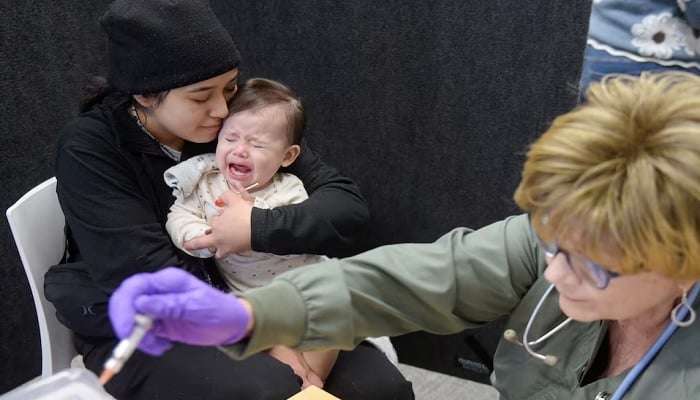

The US government released new data this week showing that rates of autism diagnoses among US children reached record highs in 2022.
Autism is a neurological and developmental condition marked by disruptions in brain signalling that cause people to behave, communicate, interact, and learn in atypical ways.
Autism diagnoses in the United States have increased significantly since 2000, intensifying public concern over what might contribute to its prevalence. Here is what you need to know.
How is autism diagnosed?
There are no objective tools for diagnosing Autism Spectrum Disorder (ASD), the medical name for autism, such as blood tests or brain scans. Instead, diagnoses are made based on observations and interviews.
The term spectrum reflects the wide range of possible manifestations. Some people with ASD may have good conversation skills, while others may be nonverbal. Some may be acutely sensitive to sounds, touch, or other triggers. Some may have restricted or repetitive behaviours or interests. Some may need help with daily living, while others require little or no support.
The American Academy of Paediatrics recommends screening all children for autism at 18 and 24 months, when most children will begin to show symptoms. Yet the average age of diagnosis remains close to 4 years in the US and 5 years globally.
How common is autism?
By 2022, the US autism rate in 8-year-olds was 1 in 31, or 3.2%, up from 2.77% in 2020, 2.27% in 2018 and 0.66% in 2000, according to the US Centers for Disease Control and Prevention. A 2021 study from England put the rate of children there at 1.76%, up from 1.57% in 2009.
The World Health Organization estimates the worldwide prevalence in children at 1%, up from 0.62% in 2012, with the caveat that many countries lack the resources to identify cases and report them.
What causes autism?
The causes of autism are unclear. There is widespread speculation among scientists that its neurological characteristics may develop in utero, when the foetal brain is being wired. Studies have linked autism to maternal factors in pregnancy, and some research suggests a link to birth complications and timing.
Genetic factors account for about 80% of the risk for developing autism, research suggests. A growing area of investigation focuses on epigenetics — the interactions between genetic and environmental factors. One theory suggests that a woman’s exposure to air pollution or harmful contaminants before or during pregnancy may trigger a genetic mutation leading to autism in her child.
Gene variations in some people with autism strengthen the evidence for a genetic component. Among the genetic disorders linked with higher risks for autism are Fragile X syndrome, tuberous sclerosis complex, Phelan-McDermid syndrome, and Prader-Willi syndrome.
Other potential risk factors may include very low birth weight, jaundice as a newborn, complications in utero or during birth, having an unhealthy assortment of organisms living in the intestines, immune system disorders, having a sibling with autism, and parental factors such as age, obesity and diabetes.
US Health Secretary Robert F Kennedy Jr and other public figures have promoted a theory, contrary to scientific evidence, that childhood vaccines are a cause of autism. The idea stems from a since-debunked study from British researcher Andrew Wakefield in the late 1990s that connected a rise in autism diagnoses with widespread use of the measles vaccine.
No rigorous studies have found links between autism and vaccines or medications, or their components such as thimerosal or formaldehyde. Vaccination rates have declined as autism rates have climbed.
Why are autism rates rising?
Researchers largely attribute the rise in autism diagnoses to more widespread screening and the inclusion of a wider range of behaviours to describe the condition. Historically, the definition of autism included moderate to severe intellectual disabilities. Today, doctors recognise that the most severe forms account for only about 25% of cases.
In 2013, mental health experts combined what had been three separate diagnoses – autistic disorder, Asperger’s disorder and pervasive developmental disorder – under the umbrella of autism spectrum disorder.
An October 2024 study of US insurance claims data found the largest increases in diagnoses were in groups with low screening rates in the past, including young adults, females, and children from some racial or ethnic minority groups.
Researchers have also noted that certain risk factors have become more common, such as having been born prematurely or to older parents.
Diagnoses of more severe forms of the disorder, known as profound autism, have not risen as dramatically as rates of non-profound autism, the CDC has reported.
Kennedy has said without scientific evidence that environmental factors are to blame for autism’s rising prevalence and that he plans to commission studies to identify them.
Are there treatments?
There are no treatments or cures for autism, nor can it be reversed. However, experts agree that early diagnosis is crucial. Intervention with supportive measures – ideally before age three – is critical for improving cognitive, social and communication skills.
Such measures can include speech therapy, occupational therapy, social skills training, sensory integration therapy, visual aids, structured routines, individualised education plans, family therapy, and providing a calm and predictable environment.




